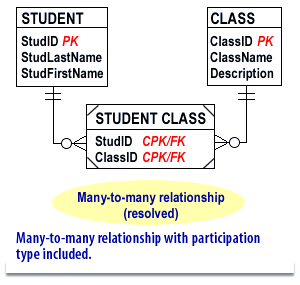| Lesson 6 | Diagramming types of participation |
| Objective | Identify the symbols for diagramming types of participation. |
Diagramming Types of Participation
In data modeling, participation refers to the involvement of an entity type in a relationship type. The types of participation are typically categorized as either "total" or "partial". Total participation means that every instance in the entity set participates in at least one relationship in the relationship set. Partial participation means that not all instances in the entity set are necessarily involved in the relationship.
During the data modeling process, Entity-Relationship Diagrams (ERDs) are often used to illustrate these participation types.
Optionality is another concept closely tied with participation. If an entity's participation is optional in a relationship, it means instances of that entity may or may not participate in the relationship. This is usually represented by a circle ('o') placed on the relationship line closest to the optional entity.
These diagramming conventions for total and partial participation in ERDs are integral for correctly representing the cardinality and participation of relationships during the data modeling process. They provide clarity and precision in defining how entities interact and relate to each other within the modeled system.
During the data modeling process, Entity-Relationship Diagrams (ERDs) are often used to illustrate these participation types.
- Total Participation: Total participation is depicted by a double line connecting the entity to the relationship. It denotes that every instance of that entity is involved in the relationship. For example, in a relationship between 'Student' and 'Course' with a 'Registers' relationship type, if every student must register for at least one course, then the 'Student' entity would be connected to the 'Registers' relationship with a double line, indicating total participation.
- Partial Participation: Partial participation is shown by a single line connecting the entity to the relationship. It indicates that not all instances of the entity are required to participate in the relationship. For instance, in the same 'Student'-'Course' relationship, if not all courses are necessarily registered by a student, then the 'Course' entity would be connected to the 'Registers' relationship with a single line, indicating partial participation.
Optionality is another concept closely tied with participation. If an entity's participation is optional in a relationship, it means instances of that entity may or may not participate in the relationship. This is usually represented by a circle ('o') placed on the relationship line closest to the optional entity.
These diagramming conventions for total and partial participation in ERDs are integral for correctly representing the cardinality and participation of relationships during the data modeling process. They provide clarity and precision in defining how entities interact and relate to each other within the modeled system.
The following series of images describe the following relationship types:
- 1:1,
- 1:N, and
- resolved M:N
Participation Symbols and ER diagrams



- 1:1 relationship with participation symbols
- 1:N relationship with participation symbols
- M:N relationship with participation symbols.
DB Participation Types
ER Diagram Participation - Exercise
Before moving on to the next lesson, click the Exercise link below to check your mastery of relationship constructs and participation symbols.
ER Diagram Participation - Exercise
The next lesson discusses the importance of meeting again with the database's eventual end users to determine if any revisions to the completed ER diagram are needed.
ER Diagram Participation - Exercise
The next lesson discusses the importance of meeting again with the database's eventual end users to determine if any revisions to the completed ER diagram are needed.